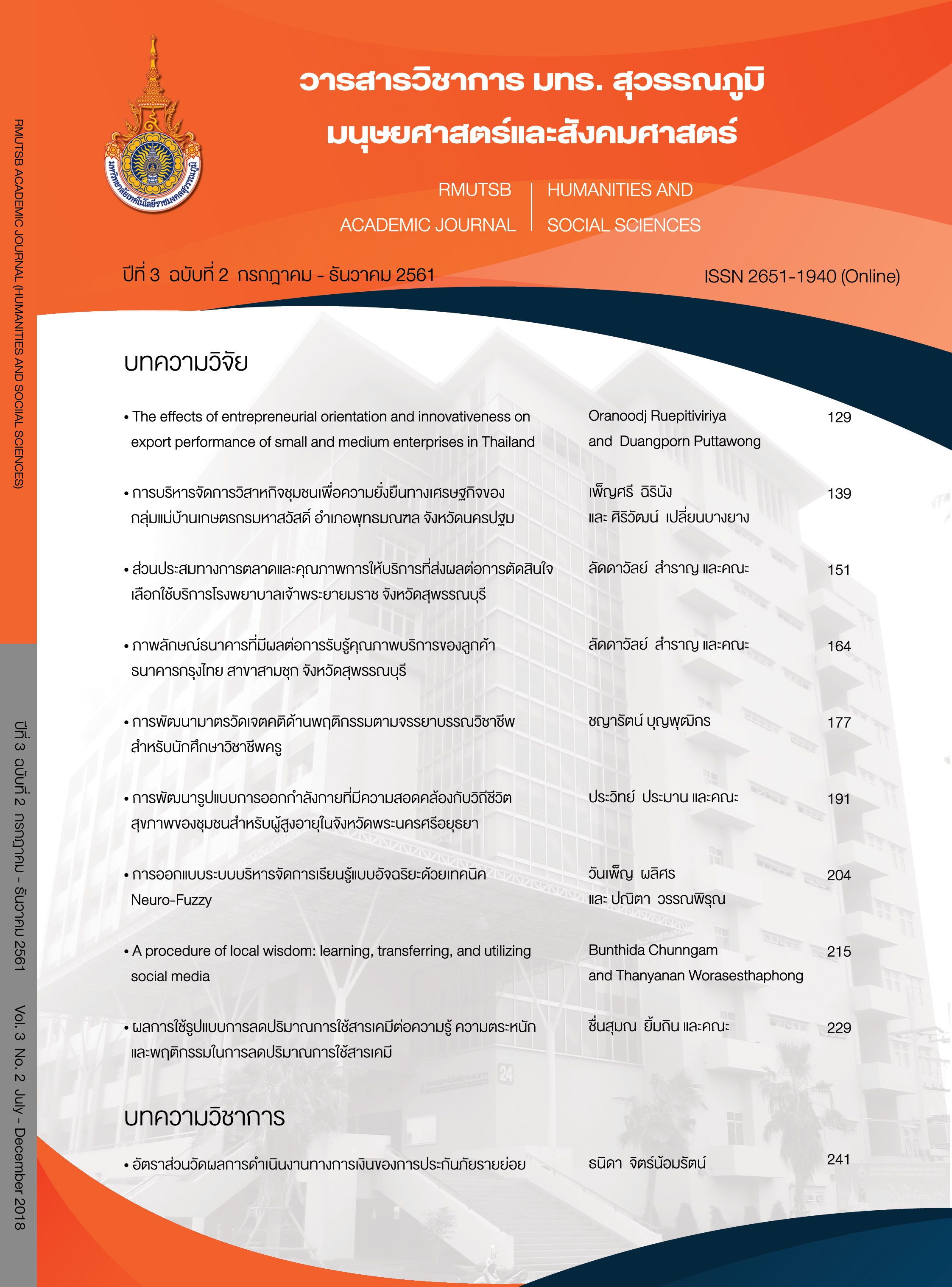Development of attitude scales on behavioral according to code of ethics of teaching profession for student teachers
Main Article Content
Abstract
The purposes of this research were to develop attitude scales on behaviors according to the code of ethics of teaching profession for student teachers, and to present the construction results of scores interpretation on developed scales. The research methodology was divided into 2 stages. At stage 1, the scales were developed by investigating the construct validity according to the code of ethics of teaching profession for student teachers. The scale validity was evaluated. The item quality of the items according to the test response was analyzed. At stage 2, the criteria of attitude scale interpretation on behaviors according to the code of ethics of teaching profession for student teachers was constructed. The sample 537 was fourth year undergraduate students in the Faculty of Education, 2017 Academic Year, in 7 public education institutes, the sample was selected by using the multi-stage random sampling. The research results revealed as follows:
1. There were 34 items of attitude scale on behaviors according to the code of ethics of teaching profession for student teachers was developed. Each item passed the criteria of content validity (I-CVI ≥ 0.80). The overall reliability was 0.92. Each item quality according to the item response theory (IRT) by item-total correlations was equally to 0.56-0.77 and statistic value of the OUTFIT MNSQ was between 0.63-1.37 and the INFIT MNSQ was between 0.67 and 1.38.
2. The interpretation criteria of the developed scale consisted of raw scores, percentile rank, Z-score,
T-score, and stanine by the teacher's attitude, is divided into 5 levels (very high, high, moderate, low and very low).
Article Details
References
ชัยวิชิต เชียรชนะ. (2013). Multidimensional analysis. วารสารศึกษาศาสตร์, 32(4), 13-22.
ราชบัณฑิตยสถาน. 2556. พจนานุกรมฉบับราชบัณฑิตสถาน พ.ศ. 2554 (พิมพ์ครั้งที่ 2). กรุงเทพฯ: นานมีบุคส์พับลิเคชั่นส์.
สุกัญญา ทองนาค, ศิริชัย กาญจนวาสี, และ สุพจน์ เกิดสุวรรณ์. (2013). การพัฒนาแบบทดสอบวัด สมรรถนะนักศึกษาครุศาสตร์/ศึกษาศาสตร์ ตามมาตรฐานวิชาชีพครูที่มีการตรวจให้คะแนนแบบพหุวิภาค. SDU Research Journal Humanities and Social Sciences, 9(1), 169-188.
สมนึก ภัททิยธนี. (2549). การวัดผลการศึกษา (พิมพ์ครั้งที่ 5). กาฬสินธุ์: ประสานการพิมพ์.
Alfadl, A. A., Ibrahim, M., I. b. M., & Hassali, M. A. A. (2013). Scale development on consumer behavior toward counterfeit drugs in a developing country: a quantitative study exploiting the tools of an evolving paradigm. BMC public health, 13(1), 829-837.
Baghaei, P. (2008). The Rasch model as a construct validation tool. Rasch measurement transactions. Retrieved 29 May 2009, from: http://www.rasch.org/rmt/rmt221a.htm
Crocker, L., & Algina, J. (2008). Introduction to classical and modern test theory. United States of America: Cengage Learning.
Edmonds, W. A., & Kennedy, T. D. (2017). An applied guide to research designs: Quantitative, qualitative, and mixed methods. Los Angeles, USA: Sage.
Graveto, J. M., Cardoso, R. J., & Silva, F. A. (2015). Construction and Validation of the Escala de Comportamentos de Abordagem aos Média por Enfermeiros (Scale of Media Use Behaviours by Nurses). Revista de Enfermagem Referência, 4(7), 61-71.
Gregory, R. J. (2007). Psychological testing: history, principles, and applications. Boston: Pearson/Allyn and Bacon.
Hair, J. F., Black, W. C., Babin, B. J., Anderson, R. E., & Tatham, R. L. (2006). Multivariate data analysis (6th ed). New Jersey: Pearson Education.
Hambleton, R. K., Swaminathan, H., & Rogers, H. J. (1991). Measurement methods for the social sciences series, Vol. 2. Fundamentals of item response theory. Thousand Oaks, CA, US: Sage.
Miller, L. A., Lovler, R. L., & McIntire, S. A. (2013). Foundations of psychological testing: A practical approach (4th ed). Los Angeles: Sage.
Nunnally, J. C., & Bernstein, I. H. (1994). Psychometric theory (3rd ed). New York: McGraw-Hill.
Oguz, A. (2012). Developing a scale for attitudes towards the curriculum development and instruction course. Educational Sciences: Theory and Practice, 12(2), 854-860.
Polit, D. F., & Beck, C. T. (2008). Nursing research: Generating and assessing evidence for nursing practice (8th ed). Philadelphia: Lippincott Williams & Wilkins.
Renthlei, M. L., & Malsawmi, H. (2015). Construction of an attitude scale towards teaching profession: A study among secondary school teachers in Mizoram. International Journal of Art, Humanities and Management Studies, 1(4), 29-36.
Samajima, F. (1994). Estimation of reliability coefficients using the test information function and its modifications. Applied Psychological Measurement, 18(3), 229-244.
Thomas, M. L. (2011). The value of item response theory in clinical assessment: A review. Assessment, 18(3), 291-307.
Uyanik, G. (2016). Investigation of the self-efficacy beliefs in teaching science and attitudes towards teaching profession of the Candidate teachers. Universal Journal of Educational Research, 4(9), 2119-2125.
Wright, B. D., Linacre, J. M., Gustafson, J. E., & Martin-Lof, P. (1994). Reasonable mean-square fit values. Rasch measurement transactions, 8(3), 370.


